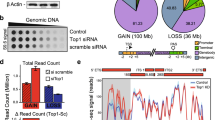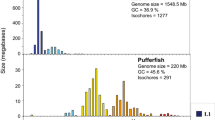Abstract
Both transcription-associated and replication-associated strand compositional asymmetries have recently been shown in vertebrate genomes. In this paper, we illustrate that transcription-associated strand compositional asymmetries and replication-associated ones coexist in most vertebrate large genes, although in most case the former conceals the latter. Furthermore, we found that the transcription-associated strand compositional asymmetries of housekeeping genes are stronger than those of somatic cell expressed genes. Together with other evidence, we suggest that germline transcription-associated strand asymmetric mutations may be the main cause of the transcription-associated strand compositional asymmetries.


Similar content being viewed by others
Abbreviations
- CSD:
-
Cumulative skew diagram
- CSDD:
-
Cumulative skew difference diagram
References
Lobry JR (1996) Asymmetric substitution patterns in the two DNA strands of bacteria. Mol Biol Evol 13(5):660–665
Francino MP, Ochman H (1997) Strand asymmetries in DNA evolution. Trends Genet 13(6):240–245
Grigoriev A (1998) Analyzing genomes with cumulative skew diagrams. Nucleic Acids Res 26(10):2286–2290
Mrazek J, Karlin S (1998) Strand compositional asymmetry in bacterial and large viral genomes. Proc Natl Acad Sci USA 95(7):3720–3725
Reyes A, Gissi C, Pesole G, Saccone C (1998) Asymmetrical directional mutation pressure in the mitochondrial genome of mammals. Mol Biol Evol 15(8):957–966
Frank AC, Lobry JR (1999) Asymmetric substitution patterns: A review of possible underlying mutational or selective mechanisms. Gene 238(1):65–77
Grigoriev A (1999) Strand-specific compositional asymmetries in double-stranded DNA viruses. Virus Res 60(1):1–19
Rocha EPC, Danchin A, Viari A (1999) Universal replication biases in bacteria Mol Microbiol 32(1):11–16
Lobry JR, Sueoka N (2002) Asymmetric directional mutation pressures in bacteria. Genome Biol 3(10): research0058.0051–0058.0014
Tillier ERM, Collins RA (2000) The contributions of replication orientation, gene direction, and signal sequences to base-composition asymmetries in bacterial genomes. J Mol Evol 50(3):249–257
Kowalczuk M, Mackiewicz P, Mackiewicz D, Nowicka A, Dudkiewicz M, Dudek MR, Cebrat S (2001) DNA asymmetry and the replicational mutational pressure. J Appl Genet 42(4):553–577
Beletskii A, Bhagwat AS (1998) Correlation between transcription and C to T mutations in the non-transcribed DNA strand. Biol Chem 379(4–5):549–551
Francino MP, Ochman H (2001) Deamination as the basis of strand-asymmetric evolution in transcribed Escherichia coli sequences. Mol Biol Evol 18(6):1147–1150
Zeigler DR, Dean DH (1990) Orientation of genes in the Bacillus subtilis chromosome. Genetics 125(4):703–708
McLean MJ, Wolfe KH, Devine KM (1998) Base composition skews, replication orientation, and gene orientation in 12 prokaryote genomes. J Mol Evol 47(6):691–696
Rocha EP, Danchin A (2003) Essentiality, not expressiveness, drives gene-strand bias in bacteria. Nat Genet 34(4):377–378
Baran RH, Ko H (2006) An Ising model of transcription polarity in bacterial chromosomes. Physica A 362(2):403–422
Nikolaou C, Almirantis Y (2005) A study on the correlation of nucleotide skews and the positioning of the origin of replication: different modes of replication in bacterial species. Nucleic Acids Res 33(21):6816–6822
Baran RH, Ko H, Jernigan RW (2003) Methods for comparing sources of strand compositional asymmetry in microbial chromosomes. DNA Res 10(3):85–95
Green P, Ewing B, Miller W, Thomas PJ, Green ED (2003) Transcription-associated mutational asymmetry in mammalian evolution. Nat Genet 33(4):514–517
Majewski J (2003) Dependence of mutational asymmetry on gene-expression levels in the human genome. Am J Hum Genet 73(3):688–692
Niu DK, Lin K, Zhang DY (2003) Strand compositional asymmetries of nuclear DNA in eukaryotes. J Mol Evol 57(3):325–334
Touchon M, Nicolay S, Audit B, Brodie of Brodie E-B, d’Aubenton-Carafa Y, Arneodo A, Thermes C (2005) Replication-associated strand asymmetries in mammalian genomes: toward detection of replication origins. Proc Natl Acad Sci USA 102(28):9836–9841
Brodie of Brodie E-B, Nicolay S, Touchon M, Audit B, d’Aubenton-Carafa Y, Thermes C, Arneodo A (2005) From DNA sequence analysis to modeling replication in the human genome. Phys Rev Lett 9424(24):248103
Hou WR, Wang HF, Niu DK (2006) Replication-associated strand asymmetries in vertebrate genomes and implications for replicon size, DNA replication origin, and termination. Biochem Biophys Res Commun 344(4):1258–1262
Touchon M, Nicolay S, Arneodo A, d’Aubenton-Carafa Y, Thermes C (2003) Transcription-coupled TA and GC strand asymmetries in the human genome. FEBS Lett 555(3):579–582
Touchon M, Arneodo A, d’Aubenton-Carafa Y, Thermes C (2004) Transcription-coupled and splicing-coupled strand asymmetries in eukaryotic genomes. Nucleic Acids Res 32(17):4969–4978
Chamary JV, Parmley JL, Hurst LD (2006) Hearing silence: non-neutral evolution at synonymous sites in mammals. Nat Rev Genet 7(2):98–108
Parmley JL, Chamary JV, Hurst LD (2006) Evidence for purifying selection against synonymous mutations in mammalian exonic splicing enhancers. Mol Biol Evol 23(2):301–309
Pozzoli U, Riva L, Menozzi G, Cagliani R, Comi GP, Bresolin N, Giorda R, Sironi M (2004) Over-representation of exonic splicing enhancers in human intronless genes suggests multiple functions in mRNA processing. Biochem Biophys Res Commun 322(2):470–476
Lobry JR (1996) A simple vectorial representation of DNA sequences for the detection of replication origins in bacteria. Biochimie 78(5):323–326
Zhang R, Zhang C-T (2005) Identification of replication origins in archaeal genomes based on the Z-curve method. Archaea 1(5):335–346
Lewin B (2004) Genes, VIII edn. Pearson Prentice Hall, Upper Saddle River
Su AI, Wiltshire T, Batalov S, Lapp H, Ching KA, Block D, Zhang J, Soden R, Hayakawa M, Kreiman G et al (2004) A gene atlas of the mouse and human protein-encoding transcriptomes. Proc Natl Acad Sci USA 101(16):6062–6067
Su AI, Cooke MP, Ching KA, Hakak Y, Walker JR, Wiltshire T, Orth AP, Vega RG, Sapinoso LM, Moqrich A et al (2002) Large-scale analysis of the human and mouse transcriptomes. Proc Natl Acad Sci USA 99(7):4465–4470
Karlin S, Campbell AM, Mrazek J (1998) Comparative DNA analysis across diverse genomes. Annu Rev Genet 32:185–225
Gierlik A, Kowalczuk M, Mackiewicz P, Dudek MR, Cebrat S (2000) Is there replication-associated mutational pressure in the Saccharomyces cerevisiae genome? J Theor Biol 202(4):305–314
Chelly J, Concordet JP, Kaplan JC, Kahn A (1989) Illegitimate transcription: transcription of any gene in any cell type. Proc Natl Acad Sci USA 86(8): 2617–2621
Kimoto Y (1998) A single human cell expresses all messenger ribonucleic acids: the arrow of time in a cell. Mol Gen Genet 258(3):233–239
Sarkar G, Sommer SS (1989) Access to a messenger RNA sequence or its protein product is not limited by tissue or species specificity. Science 244(4902):331–334
Niu D-K (2005) Low-level illegitimate transcription of genes may be to silence the genes. Biochem Biophys Res Commun 337(2):413–414
Acknowledgments
We thank Lei Zhu and Shu-Wei Li for technical helps. This work was supported by the National Natural Science Foundation of China (30270695) and Beijing Normal University.
Author information
Authors and Affiliations
Corresponding author
Electronic supplementary material
Below is the link to the electronic supplementary material
Rights and permissions
About this article
Cite this article
Wang, HF., Hou, WR. & Niu, DK. Strand compositional asymmetries in vertebrate large genes. Mol Biol Rep 35, 163–169 (2008). https://doi.org/10.1007/s11033-007-9066-6
Received:
Accepted:
Published:
Issue Date:
DOI: https://doi.org/10.1007/s11033-007-9066-6




